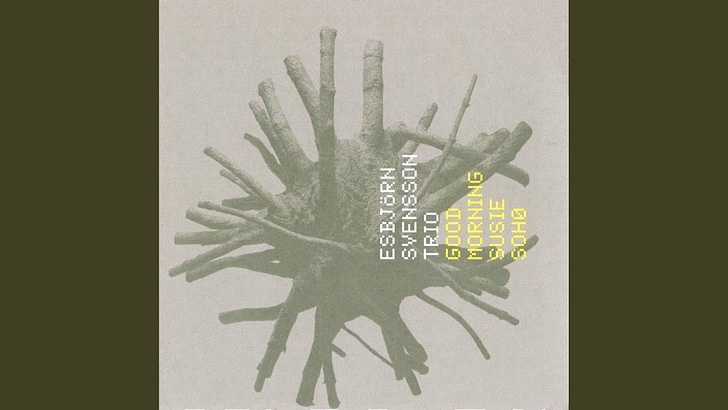Swedish pianist Esbjorn Svensson died on June 14, 2008 in a diving accident off of Stockholm. He was forty four years of age. Svensson was the pianist and leader of the Swedish piano trio, E.S.T. (for Esbjorn Svensson Trio), a modern group that confounded and delighted listeners and critics alike in their ability to further the language of the piano trio while retaining elements from within the tradition. The group was thoroughly modern , but with much romanticism and an understanding of the history and language of the jazz piano trio. Like the Marcin Wasilewski Trio, E.S.T. had the ability to alternate highly impressionistic music with more driving rhythmic grooves. They also took a page from rock and pop bands and presented themselves along with light shows and staging of their performances as well as embracing video culture. Despite this, it would be a mistake to assume that E.S.T. was some kind of fusion group or that they couldn’t bear comparison with other serious jazz piano trios of the day.
Svensson was honestly perplexed by the need for many music fans and critics to label music—his or anybody else’s. In a 2004 interview, Svensson said “I mean, what we're doing, if you have to call it something... I guess it's jazz, but it's not what jazz was.” That is true, because so much goes into the music of E.S.T., most of which was composed by Svensson: jazz, grooves, electronic, rock, pop. Part of the genius of this band was its ability to draw from all of these sources and come up with something that was uniquely their thing. The funk laden groove of “Good Morning Susie Soho” is something few bands, jazz, rock, or pop, could manage to bring off with the same kind of panache. At the same time, his compositions showed an appreciation of, and influence by, classical composers from Bach to Bartok. The counterpoint of the Baroque era seemed to hold special fascination for the pianist.
Although the trio used various techniques to alter or color their sound, they remained a steadfastly acoustic trio otherwise. Svensson would use prepared piano or pluck the instrument’s strings at times, while bassist Dan Berglund uses distortion and other pedals as well as his bow to give the group interesting and, seemingly electrified sounds. But these effects were applied to live performances, not manipulated afterward. The group’s unique aesthetic—think of your favorite ECM trio crossed with some kind of modern electronic pop music.—allowed listeners raised on pop music, but open to new sounds to really hear what they were doing.
During their 15 year career the group recorded thirteen albums, a major body of work in such a time span. The group’s first recording, 1993’s When Everyone Has Gone featured “Stella By Starlight” as well as many original compositions, including “Mohammed Goes to New York” and “Silly Walk.” In 1995 the group released Live ’95 followed by ‘97’s Esbjorn Svensson Trio Plays Monk, an album of Thelonious Monk compositions. In ’99 came From Gagarin’s Point of View, the title track of which became a staple of the group’s live performances.
2000 saw the release of Good Morning Susie Soho, with its infections title track, and in 2003 the group began to really be noticed in the United States with the release of Strange Place for Snow. In Europe, they were clearly the most popular and well known trio, and these two Sony releases really put the group on the map in the States.
E.S.T. live in Stockholm was a 2003 DVD release that allowed many listeners their first glimpse of the group playing live. Released together with the phenomenal CD Seven Days of Falling (the CD contained an edited four-song version of the DVD) on independent label 215 Records, it showed a group that was maturing and very much in control of its sound. Viaticum appears to be available as an import only, from ACT Records. Tuesday Wonderland provided the listening experience that fans of the group had come to expect, but also dished out a bit more dissonance and a darker tone than usual.
It seems perfectly clear that E.S.T., and certainly Esbjorn Svensson, were not able to finish their musical mission on this planet. It is likely that the group would have remained an influential force in the European jazz community, as well as an influence on many musicians in the U.S., despite a lack of visibility to the general public. Fortunately, the recordings that Svensson has left provide ample evidence as to his approach to making music, and there is no doubt that many musicians are listening to him and experiencing his rare combination of musical depth and popular appeal. Svensson’s music could provide the careful listener with a doorway to a deep, resounding sense of peace or of joy and celebration. There was also melancholy and a sense of the temporary nature of life.
Svensson’s music seemed to be taking an increasingly spiritual path. According to the group’s website, Tuesday Wonderland connects directly to Viaticum: “The interpretation of “Viaticum” was that the music is the provisions that you take with you on your journey through life. “Tuesday Wonderland” is the spiritual journey itself that opens new worlds.” That spiritual element was always there, of course. E.S.T.’s best work was about a journey three musicians were taking.
New Directions in Music is written by a single real person. It is not generated by AI. Please help spread good content by reading (Thank you!) and sharing this post with a music loving friend. If you like what you see, please sign up for a free subscription so you don’t miss a thing, or sign up for a paid subscription if you can.


